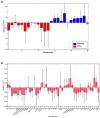Urinary Metabolomics of Plastic Manufacturing Workers: A Pilot Study
- PMID: 40126257
- PMCID: PMC11932285
- DOI: 10.3390/jox15020039
Urinary Metabolomics of Plastic Manufacturing Workers: A Pilot Study
Abstract
The plastic manufacturing industry has a crucial role in the global economy with a significant impact in a wide range of fields. The chemical risk to which workers are potentially exposed is difficult to characterize and strictly related to both the products and processes adopted. Among the chemicals used, we can cite styrene, phenol, butadiene and phthalates, but nano- and microplastic particles can also be released in the work environment. In this pilot study, we present for the first time an NMR-based metabolomic approach for assessing urinary profiles of workers employed in a plastic manufacturing company. Urine samples from twelve workers and thirteen healthy volunteers were collected and analyzed by NMR spectroscopy. Forty-six urinary metabolites belonging to different chemical classes were univocally identified and quantified. The dataset so obtained was then subjected to multivariate statistical analysis to characterize each profile and highlight any differences. An alteration in some metabolites involved in several pathways, such as amino acid metabolism and NAD metabolism, was found, and a strong impact on gut microflora was also speculated. Ultimately, our work has the objective of adding a tile to the knowledge of biological effects possibly related to occupational exposure even if it is below the threshold limit values.
Keywords: NMR-based metabolomics; multivariate statistical analysis; occupational exposure; plastic manufacturing; urinary profile.
Conflict of interest statement
The authors declare no conflicts of interest.
Figures



References
-
- Oktavilia S., Hapsari M., Firmansyah, Setyadharma A., Wahyuningsum I.F.S. Plastic Industry and World Environmental Problems. E3S Web Conf. 2020;202:05020. doi: 10.1051/e3sconf/202020205020. - DOI
-
- OECD Global Plastics Outlook: Policy Scenarios to 2060. Organisation for Economic Co-operation and Development; Paris, France: 2022.
-
- Hazardous Exposures to Plastics in the World of Work: Research Report—International Labour Organization. [(accessed on 4 December 2024)]. Available online: https://researchrepository.ilo.org/esploro/outputs/report/Hazardous-expo....
-
- UN Environment Chemicals in Plastics—A Technical Report|UNEP—UN Environment Programme. [(accessed on 4 December 2024)]. Available online: https://www.unep.org/resources/report/chemicals-plastics-technical-report.
-
- Teuten E.L., Saquing J.M., Knappe D.R.U., Barlaz M.A., Jonsson S., Björn A., Rowland S.J., Thompson R.C., Galloway T.S., Yamashita R., et al. Transport and Release of Chemicals from Plastics to the Environment and to Wildlife. Philos. Trans. R Soc. Lond. B Biol. Sci. 2009;364:2027–2045. doi: 10.1098/rstb.2008.0284. - DOI - PMC - PubMed
Grants and funding
LinkOut - more resources
Full Text Sources

